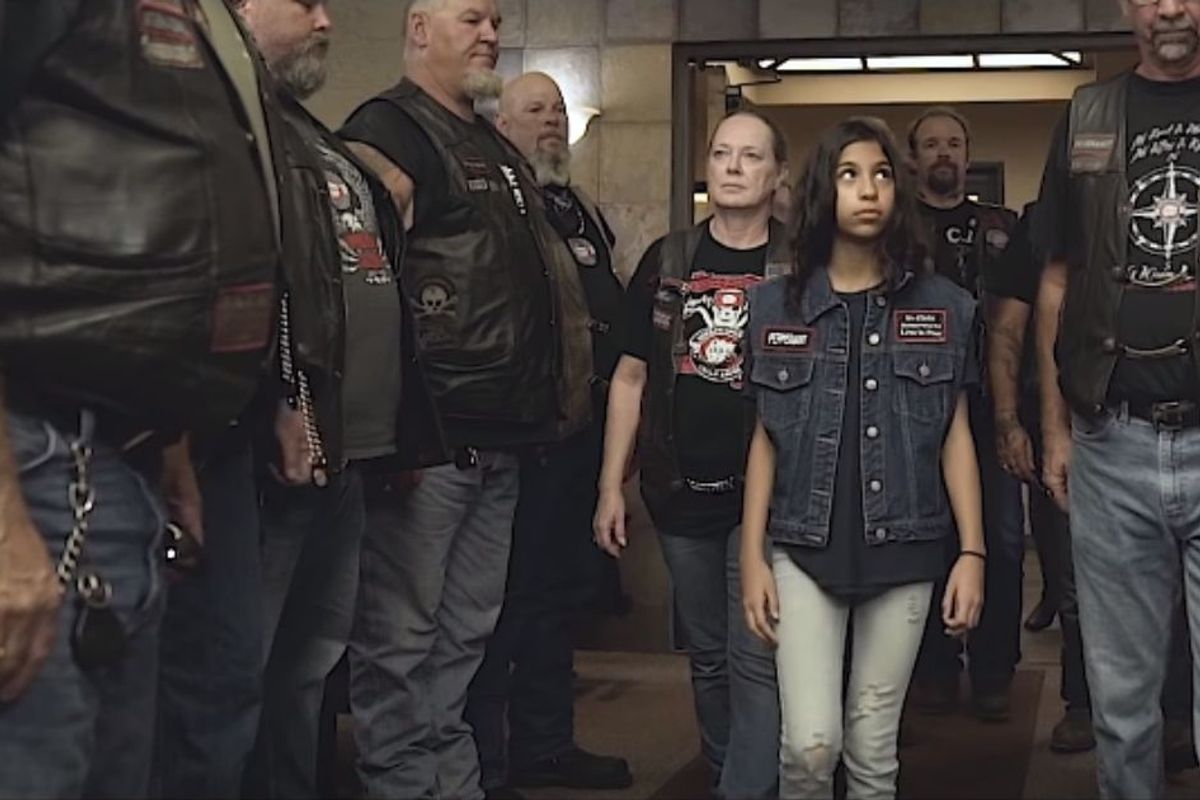Badass bikers show up for abused children, offering advocacy and protection
They become an abused child's "biker family," and they let the child—and everyone else—know that NO ONE messes with their family.

When you are a child who has been abused by people who are supposed to protect you, how do you feel safe?
That question is the heart of Bikers Against Child Abuse International (B.A.C.A.), an organization dedicated to creating "a safer environment for abused children." With specific training and extensive security checks, the frequently big and burly members of B.A.C.A. serve as protectors of chid abuse survivors, giving vulnerable children people to call on when they feel scared, and even showing up in court when a child asks them to.
In short, they become an abused child's "biker family," and they let the child—and everyone else—know that no one messes with their family.
As the B.A.C.A. mission statement says:
"We exist as a body of Bikers to empower children to not feel afraid of the world in which they live. We stand ready to lend support to our wounded friends by involving them with an established, united organization. We work in conjunction with local and state officials who are already in place to protect children. We desire to send a clear message to all involved with the abused child that this child is part of our organization, and that we are prepared to lend our physical and emotional support to them by affiliation, and our physical presence. We stand at the ready to shield these children from further abuse. We do not condone the use of violence or physical force in any manner, however, if circumstances arise such that we are the only obstacle preventing a child from further abuse, we stand ready to be that obstacle."
B.A.C.A. members do whatever they can to make abused kids feel safe, which is huge for children who have been hurt, especially by the adults who are supposed to love and protect them.
First, they set up an initial ride to welcome a child into the biker family. Kids are offered a vest and a patch, which they have the option of accepting or not—there's never pressure put on a child. They take a photograph with the child, which the child keeps to remind them that they have family to call on whenever they feel afraid. They serve as escorts when kids feel frightened to go somewhere. They show up at court hearings to help kids feel less intimidated. They come to kids' houses when called to help support the family or serve as a deterrent for further abuse.
Though B.A.C.A. absolutely does not physically confront perpetrators, simply their presence provides the message that a child has a band of protectors behind them. Watch these bikers in action:
And check out the B.A.C.A creed to see how dedicated these folks are to this work:
"I am a Member of Bikers Against Child Abuse. The die has been cast. The decision has been made. I have stepped over the line. I won't look back, let up, slow down, back away, or be still.
My past has prepared me, my present makes sense, and my future is secure. I'm finished and done with low living, sight walking, small planning, smooth knees, colorless dreams, tamed visions, mundane talking, cheap giving, and dwarfed goals.
I no longer need pre-eminence, prosperity, position, promotions, plaudits, or popularity. I don't have to be right, first, tops, recognized, praised, regarded, or rewarded. I now live by the faith in my works, and lean on the strength of my brothers and sisters. I love with patience, live by prayer, and labor with power.
My fate is set, my gait is fast, my goal is the ultimate safety of children. My road is narrow, my way is rough, my companions are tried and true, my Guide is reliable, my mission is clear. I cannot be bought, compromised, detoured, lured away, turned back, deluded, or delayed. I will not flinch in the face of sacrifice, hesitate in the presence of adversity, negotiate at the table of the enemy, ponder at the pool of popularity, or meander in the maze of mediocrity.
I won't give up, shut up, let up, until I have stayed up, stored up, prayed up, paid up, and showed up for all wounded children. I must go until I drop, ride until I give out, and work till He stops me. And when He comes for His own, He will have no problem recognizing me, for He will see my B.A.C.A. backpatch and know that I am one of His. I am a Member of Bikers Against Child Abuse, and this is my creed."
This article originally appeared on 03.05.20
- 25 things you do as an adult when you've experienced childhood ... ›
- Here's what the legacy of child abuse looks like to 1 survivor ... ›
- Child abuse pediatrician corrects falsehoods about virginity with a ... ›
- 'Old Biker Dude' becomes viral sensation thanks to TikTok - Upworthy ›
- Biker stops homeless man from jumping off bridge - Upworthy ›
- Mom races to help after seeing young man left for dead on busy road - Upworthy ›
- Biker stops to push elderly man home after his shoe broke - Upworthy ›





 Dexters Laboratory What A Fine Day For Science GIF
Dexters Laboratory What A Fine Day For Science GIF The bread doesn't lie. Facebook/Jaralee Metcalf
The bread doesn't lie. Facebook/Jaralee Metcalf luxo jr lamp GIF by Disney Pixar
luxo jr lamp GIF by Disney Pixar Plastic doesn't belong in the ocean.
Plastic doesn't belong in the ocean.
 Food Dancing GIF by Oscar Mayer
Food Dancing GIF by Oscar Mayer
 Gif from 'Mean Girls'
Gif from 'Mean Girls' GIF from 'The Wonder Years.'
GIF from 'The Wonder Years.'